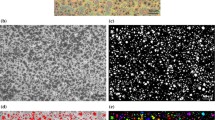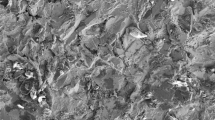Abstract
This work presents data on topographical structure, chemical surface composition, physicochemical properties and corrosion resistance of medical grade titanium after ion implantation. Pure commercial titanium has been implanted with 30 keV Na-, Ca- and P-ions at fluences of 2.0 × 1017 cm-2 and 1.5 × 1017 cm-2, respectively. Some of the samples were heat treated at 600 °C for 40 min. Atomic force microscopy (AFM) was used for surface analysis. The chemical composition was investigated using Rutherford backscattering spectrometry (RBS). Physicochemical investigations were carried out using contact angle measurements to determine the polarity of the modified titanium surfaces. Moreover, the electrokinetic zeta potentials on a physiological pH value have been determined. Finally, the corrosion resistance was examined in simulated body fluid (SBF) containing 4 g/l bovine serum albumin (BSA) using cyclic voltametry.
Considering the P-implantations, the measured depth distribution of phosphorus agrees well with calculations. For the implantation of Na and Ca, the concentration of implanted atoms in the maximum of the depth distribution is noticeably lower and the distribution extends to larger depths compared to the predictions. This finding is associated with a strong incorporation of oxygen over the whole penetration depth of the implanted ions. According to topographical and chemical changes different contact angles as well as zeta potentials have been detected for the ion implanted surfaces compared to pure titanium. The electrochemical examinations indicate that the implantation has no negative influence on the corrosion resistance in comparison to unmodified medical grade titanium. The results show that ion implantation using certain ions can be used to design tailor-made titanium surfaces from a physicochemical point of view.
Similar content being viewed by others
References
T. Kokubo, H.M. Kim, M. Kawashita and T. Nakamura, J. Mat. Sci.: Materials in Medicine 15 (2), 99 (2004).
M.T. Pham, W. Matz, H. Reuter, E. Richter, G. Steiner and S. Oswald, Surf. Coat. Technol. 128–129, 313 (2000).
E. Wieser, I. Tsyganov, W. Matz, H. Reuther, S. Oswald, T. Pham and E. Richter, Surf. Coat. Technol. 111, 103 (1999).
M.T. Pham, M.F. Maitz, W. Matz, H. Reuther, E. Richter and G. Steiner, Thin Solid Films 379, 50 (2000).
P. Li, I. Kangasniemi, K. de Groot and T. Kokubo, J. American Ceramic Soc. 5, 1307 (1994).
J.F. Ziegler, J.P. Biersack, U. Littmark, The Stopping and Range of Ions in Solids, Pergamon, New York, 2003.
N.P. Barradas, C. Jeynes and R.P. Webb, Appl. Phys. Lett. 71, 291 (1997)..
F. Schrempel, K.Y. Cai, J. Bossert, K.D. Jandt, in preparation.
F. Schrempel, G. Hildebrand, K. Liefeith, in preparation.
H. Zitter, Werkstoffe und Korrosion 39, 12, 574–582 (1988)
Author information
Authors and Affiliations
Rights and permissions
About this article
Cite this article
Schrempel, F., Hildebrand, G., Frant, M. et al. Chemical Behavior and Corrosion Resistance of Medical Grade Titanium after Surface Modification by Means of Ion Implantation Techniques. MRS Online Proceedings Library 908, 1422 (2005). https://doi.org/10.1557/PROC-0908-OO14-22
Received:
Accepted:
Published:
DOI: https://doi.org/10.1557/PROC-0908-OO14-22




